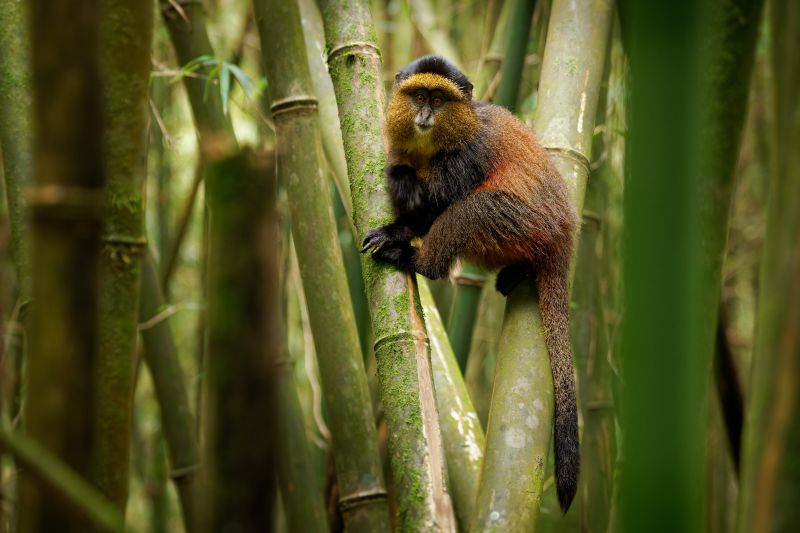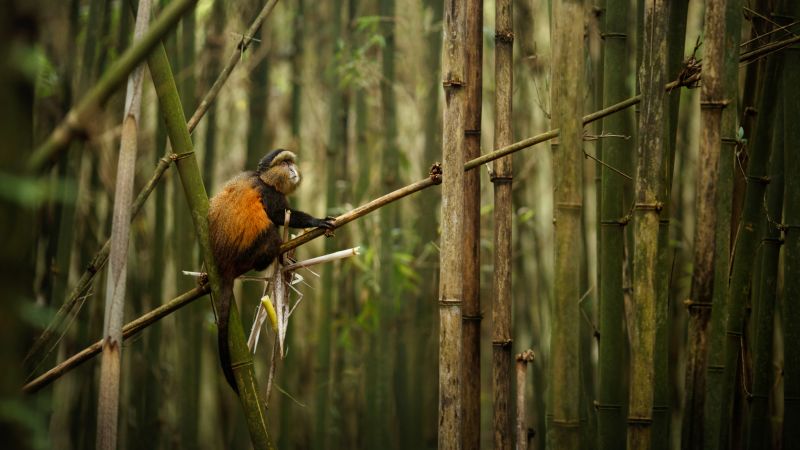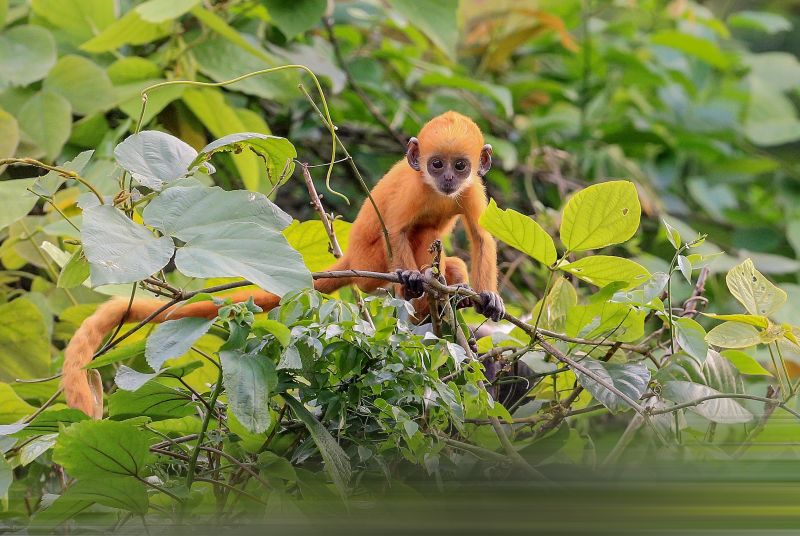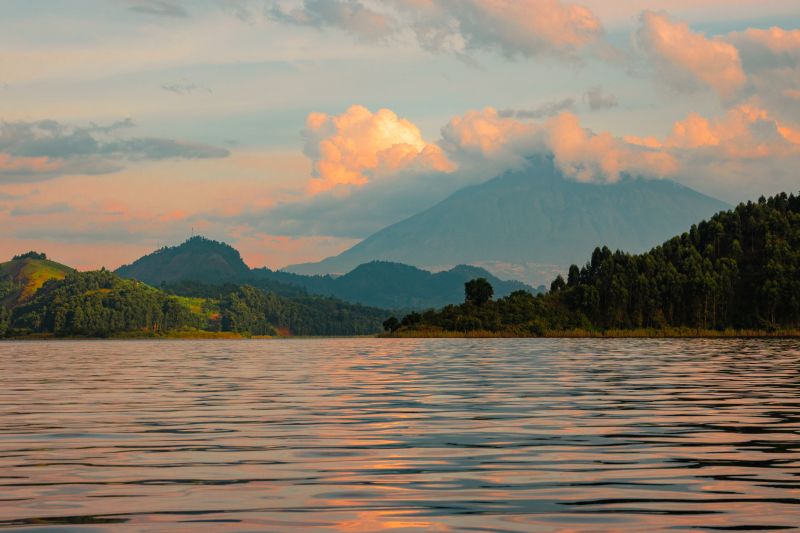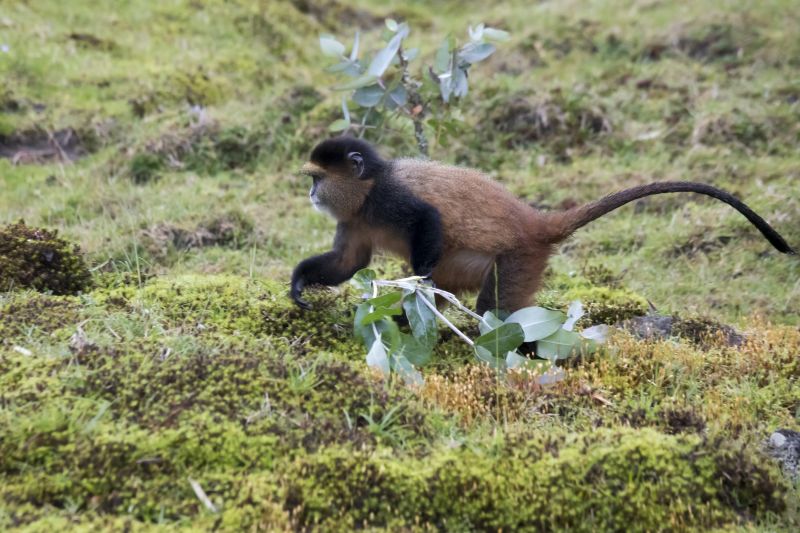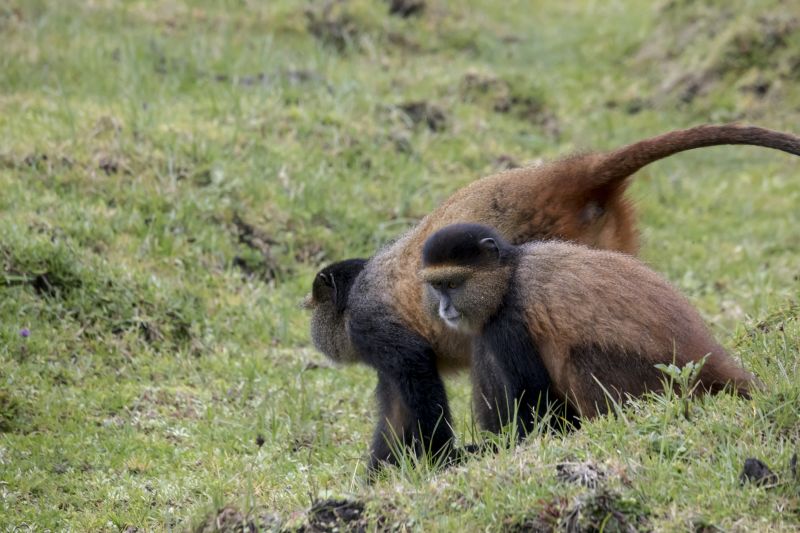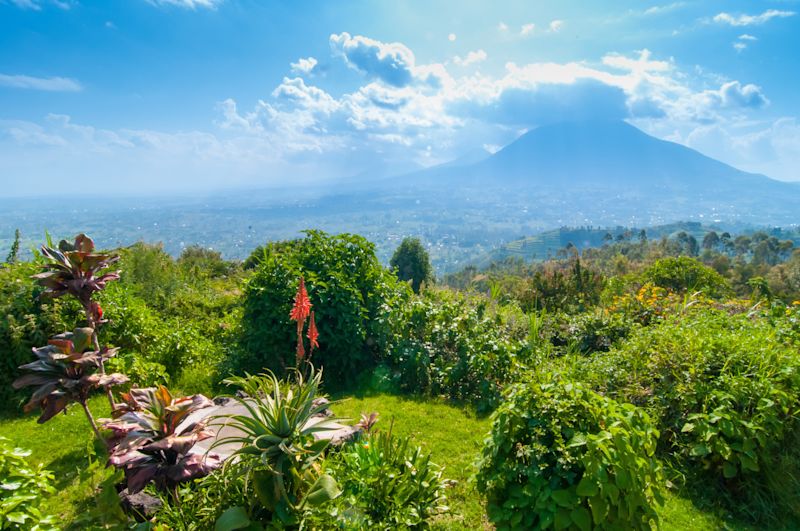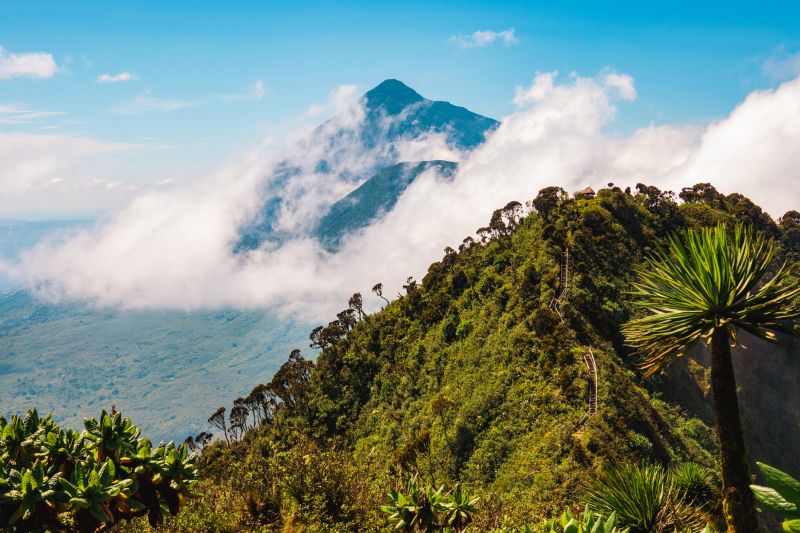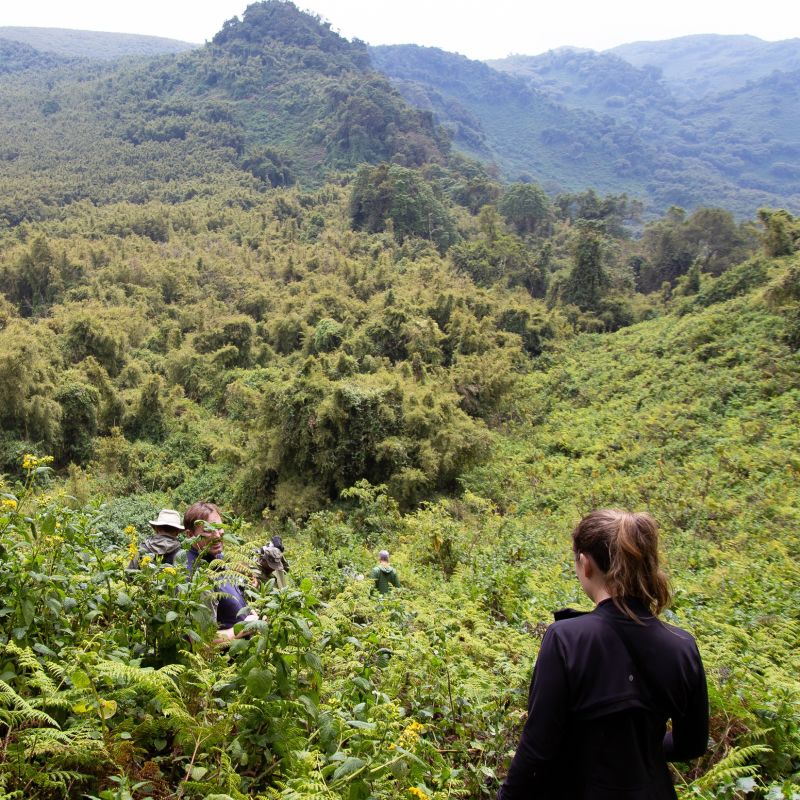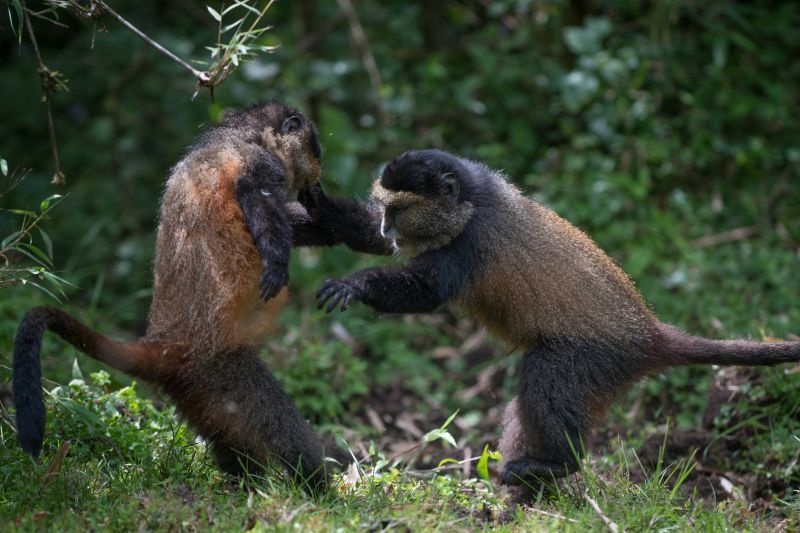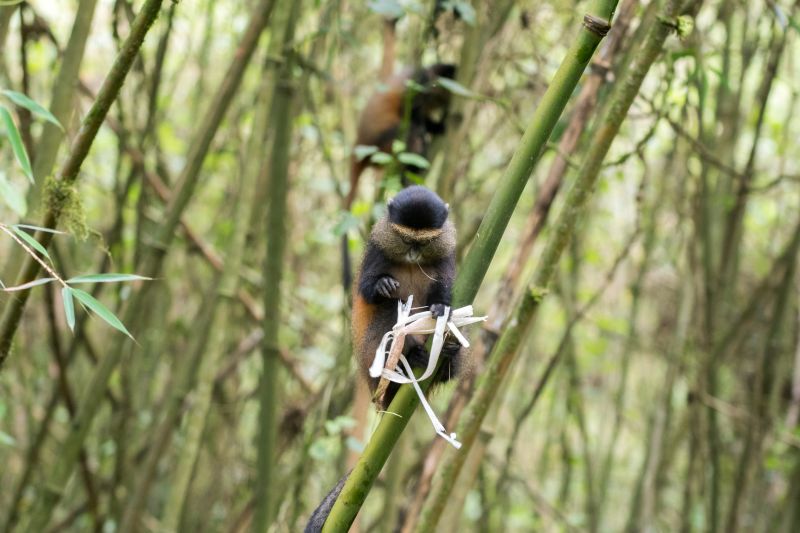Not everyone has heard of East Africa's golden monkeys. And this is in spite of the fact that they live in the same forest ecosystem as mountain gorillas.
Yet golden monkeys are a beautiful and endangered species that we think you'll love and want to visit once you know about them ...
What do I need to know about golden monkeys?
The golden monkey (Cercopithecus mitis kandti) is a very attractive Old World primate that's a subspecies of the Sykes or blue monkey.
A golden monkey sits among bamboo trees
Surprisingly little is known about golden monkeys. As per the Dian Fossey Gorilla Fund website:
The Dian Fossey Gorilla Fund has been studying gorillas in the wild for more than 55 years now, ever since Dian Fossey set up her research in 1967. But it was only in 2004 that we began studying the only other primate that lives in the forest with the mountain gorillas – the golden monkey.
Golden monkeys have round faces, prominent brows, very whiskery cheeks and flat noses. It's a very endearing composition, wouldn't you agree?
Some golden monkeys have very orangey-gold backs
The monkeys' colouring is striking, with the black that covers most of their body merging suddenly with the bright orangey-gold on their backs and upper flanks. While the intensity of the orange-like fur varies from individual to individual (it's more brown on some), it's easy to understand why they were named golden monkeys.
Here are a few further interesting facts about golden monkeys:
- They mostly live in large troops that can reach up to 100 individuals. But sometimes they can be found in very small troops that number as low as three.
- They eat mostly bamboo shoots, leaves and branches. But they also eat fruits, flowers, shrubs and insects.
- If you see some with short tails, sadly their long tails sometimes get stuck between bamboo trees.
Btw, China's golden monkeys are different
Finally, don't get Africa's golden monkeys confused with the golden monkeys you find in China. The latter are properly called golden snub-nosed monkeys (Rhinopithecus roxellana) and have little in common beyond both being primates.
Don't confuse golden monkeys with golden snub-nosed monkeys
Where do golden monkeys live?
Golden monkeys are endemic to the Virunga mountains, meaning you can only find them in the wild in this one spot of the world.
Mt Muhabura – one of the Virunga mountains – as seen from Lake Mutanda, Uganda
The Virungas aren't exactly a mountain range, but rather a collection of volcanic peaks. Golden monkeys live in the forests that cover the volcanoes' slopes up till around 3,000 m above sea level (at which point moorland takes over).
This monkey has foraged a eucalyptus branch
The Virungas are shared by Rwanda, Uganda and the DRC. In fact, the tallest mountain – Mt Sabyinyo (3,669 m) – sits in all three countries, with the peak being the spot where all of the borders meet.
Golden monkeys spend much of their time in bamboo stands, as the trees form the bulk of their diet. The thick stands also provide protection from predators like eagles.
In the rainy season they mostly sleep and eat in bamboo stands. They sometimes actually weave together small 'houses' using bamboo branches to shelter themselves from the rain.
Golden monkeys do also come out into the open at times
In the dry season, the bamboo trees dry up and they move to other areas of the forest for food and shelter.
Where can I go golden monkey trekking?
You can head to any of these national parks for golden monkey trekking (also called golden monkey tracking):
- Virunga or Kahuzi-Biéga National Parks in the DRC
- Volcanoes National Park in Rwanda
- Mgahinga Gorilla National Park in Uganda
View of Mt Sabyinyo from Volcanoes National Park
Rwanda and Uganda currently dominate the market for animal encounters like golden monkey trekking as they're the safer countries for tourists.
At Follow Alice we offer golden monkey trekking in both Uganda and Rwanda. Please check out our Wildlife of Rwanda itinerary if you're interested. Or if you'd like to do the trek in Uganda, we can custom add that to one of our Uganda itineraries for you, no problem!
Mt Sabyinyo, Mt Gahinga and Mt Muhabura in Mgahinga Gorilla National Park
What does a golden monkey trek look like?
Similar to mountain gorilla trekking and chimpanzee trekking, a golden monkey trek sees you go on a half-day, small-group, guided hike into the forest to find a troop and spend an hour in its company.
Trekkers in Volcanoes National Park
You meet your trek guide early in the morning for a briefing before heading off together to find your golden monkey troop. Trackers will have told your guide where to look for the troop that day.
The golden monkey troop that you visit is habituated to the presence of humans, which means they tend to be pretty relaxed. In fact, sometimes the monkeys are downright friendly; they've been known to come right up to you to touch your leg or stare into your camera lens.
Golden monkeys are perfectly safe to be around provided you don't provoke them. They're actually really friendly primates.
Two golden monkeys at play
Of course you shouldn't try to touch a monkey, or attempt to pick one up. They're still wild animals. It's also important that visitors try not to prompt certain reactions from the monkeys. You want to minimise the impact of your visit. Also, you don't want to risk spreading any communicable diseases to them.
Want to spend longer with a troop?
If you're all about the animals and an hour just isn't enough, then you can opt for a golden monkey habituation experience, which costs more but lets you spend four hours with a troop.
Two golden monkeys enjoying a bamboo meal
For most people, the regular golden monkey trek is sufficient. But for those with a special interest in primates, it might be worth the extra spend to be able to linger in their presence and really observe the troop's behaviours over a longer period of time.
Note that on an habituation experience the golden monkeys might be shyer. This is because you're dealing with a troop that is in the process of becoming habituated to the presence of humans.
A golden monkey sits in a eucalyptus tree in Volcanoes National Park
Do I need to be fit for the trek?
Yes, you need to be walking fit to manage a golden monkey trek comfortably. Precisely how far or long you have to hike depends on the location of the troop on the day that you're visiting.
On the trek you're going to be walking first through farmland and then up and down narrow, steep, rocky and often muddy forest paths. You won't, however, climb as high as the subalpine or moorland zone.
On a golden monkey trek you stay within the forested zone of the Virungas, which extends to roughly 3,000 m above sea level. But most likely you won't climb nearly that high.
If you want to climb above the forest for incredible views, you must do a separate hike
Note that you can hire the services of a porter for the trek if you like. Not only will your porter carry your backpack, but they'll also hold your hand on tricky sections of the trail if you like. So we recommend you give the trek a try even if you're nervous of slippery forest trails; just ensure you're capable of hiking for a few hours at a reasonable pace.
Finally, we can happily arrange for you to do a hike that takes you above the tree line and into the unusual and beautiful moorland zone of the Virungas if you'd like. This will just need to be done on a different day to the golden monkey trek.
Golden monkeys stick to the forests, which don't reach all the way to the volcanoes' peaks
How much does the trek cost?
Whether you're doing a golden monkey trek in Mgahinga Gorilla National Park in Uganda or in Volcanoes National Park in Rwanda, you'll be charged US$100 as a foreigner. This fee covers your guide's salary while also supporting the park's conservation efforts.
A mother golden monkey with her infant
Please note that tipping is customary in Uganda and Rwanda. Your trek guide, for instance, will be hoping for a tip. We recommend budgeting around US$10 to 15 for this.
As mentioned, you also have the option of hiring the services of a porter to help you on the hike. Porter costs vary and are usually negotiable, but you should be able to budget at most $20 for a porter, including a tip.
A golden monkey spotted in deep forest in Volcanoes National Park
What must I pack for the trek?
Similarly to mountain gorilla trekking, the most important items to pack for a golden monkey trek are:
- A backpack (with a rain cover)
- Waterproof or -resistant hiking boots
- A poncho or rain jacket
- Long pants (to prevent your legs getting scratched)
- Sunscreen
- Sunhat
- Sunglasses
- Insect repellent
- Drinking water
- Snacks
- Camera
A hiker heads up Mt Gahinga in Mgahinga Gorilla National Park
Also, here are some optional items you might like to bring along:
- Gardening gloves or similar so you can hold onto branches and other vegetation when climbing without getting cut.
- Gaiters to ensure your boots and legs stay dry.
- Trekking poles or a walking stick (although sometimes you're actually given a complimentary walking stick for the trek).
Mountain gorillas live in the same forests as golden monkeys
As mentioned earlier, golden monkey trekking can be done in the exact same locations as gorilla trekking. You're also not far from chimpanzee trekking sites. So a trip to Rwanda or a trip to Uganda really is the ideal holiday for anyone who would love to enjoy more than just one incredible and rare animal encounter!


